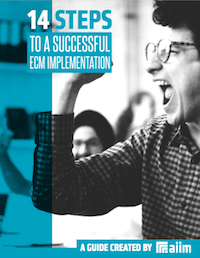The AIIM Blog
Keep your finger on the pulse of Intelligent Information Management with industry news, trends, and best practices.
Knowledge is power - both in our personal lives and work lives. But, in our organizations, the management of this knowledge is one of the most crucial yet overlooked aspects of workplace progress. When employees fail to get access to the knowledge necessary for completing their tasks, the organization can suffer. In fact, there are many benefits to using a practice called Knowledge Management to purposefully manage your organization's knowledge assets and ensure access. Today, we'll be exploring an aspect of Knowledge Management called Expertise Location - the idea, in a nutshell, is to manage knowledge by identifying experts on a particular topic and then leveraging that expertise in support of business goals and objectives. Every company has experts on different topics, and Expertise Location is a way to formalize and easily identify and track where to go to leverage this expertise. Ready? Let's jump in!
Share
This post is focused on the following topics. You may click these links to jump to a specific section:
Share

Making an ECM implementation successful requires planning and attention to detail. The best way to create the right solution is to identify organizational goals and priorities. Learn how to manage a successful implementation in our free guide.
Document Management is the use of a software application to track digital documents from creation through approval and publication. It serves in many ways to apply a formal governance framework to the document creation and collaborative editing processes.
Share
In a truly all-digital world, there would be no need for printers – or scanners or document couriers. Documents would never need to be printed, and processes would run smoothly from all-electronic input to all-electronic output. This may already the reality for some leading companies, but for most organizations, forms, contracts, agreements, and signoffs are still rooted in wet ink on paper. In this post, we’ll examine the importance of signatures for various organizations - particularly for process sign-offs and professional authorizations, look at the drivers for electronic signing, the issues that might be preventing adoption, and look at how the AIIM Community views digital signatures. Sound good? Great, let’s dive right in!
Share
We’ve covered the importance of Information Capture on the blog before and explored how capture represents the first step in the information lifecycle. In this step, we “capture” or gather information into our business ecosystem to store, manage, protect, and ultimately it use for business value. It ALL starts with capture. But, the value of a document is in its content, not whether it was received as an email attachment, captured via a smart phone or tablet, or scanned using a multifunction device. Therefore, multichannel capture takes into account that your business likely has multiple channels or sources of information flowing in and out of your business. As we will discover together, these channels often need to be treated individually, and your Information Capture strategy must take into account the differences from channel to channel.
Share
Electronic Records Management (ERM)
In another post this week, we took a look at the first step in the information lifecycle – information capture. We not only talked about the importance of capture, but we also talked about what you should be capturing and what you should avoid capturing. Today, I’d like to dig a little deeper into that discussion and talk about how to distinguish between a record and a non-record. This is an important distinction to make when developing your Information Capture strategy. If you are new to records management, some of the following may need a little getting used to, especially if you associate ‘anything that is in a file’ with the idea of ‘record’. In fact, many items that people keep, or file, are definitely not records. Let's start out with some examples of what is typically considered a record and what is typically NOT considered a record.
Share